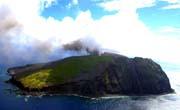IZU-TORISHIMA, Izu-Marian
islands
(Iwoyama 394m, 30o28'48"N,
140o18'22"E)
(08/21/02)
According to the aerial inspection by Japan Coast Guard on August 21
(through JMA), Izu-Torishima had not smoked any longer, except for
weak steaming in the southern part of the crater. However, faint
discolored sea surface was observed around the island.
(08/15/02)
According to the information from Japan Coast Guard (through JMA),
which is carring out the air inspection of the volcanic activity at
Izu-Torishima, the eruption activity had continued as of the noon of
August 14; the eruption cloud reached about 4,000 ft (5,000 ft as
maximum) above the sea level on August 13, and about 3,000 feet on
August 14. Three active areas from which smokes were emitted were
observed along the western inner-wall of the summit crater. The
crater seems to have widened during eruption. Discolored sea surface
disappeared on August 14.
 photo1
photo1  photo2
photo2  photo3
photo3
Photo1: Northwestern view of Izu-Torishima around the August 13 noon.
Courtesy of Japan Coast Guard.
Photo2: Southwestern view of Izu-Torishima around the August 13 noon.
Courtesy of Japan Coast Guard
Photo3: Discolored sea surface NW of the island around the August 13
noon. Courtesy of Japan Coast Guard
 photo 4
photo 4  photo5
photo5
Photo4: View of Izu-Torishima on the August 14 aftenoon. Courtesy of
Japan Coast Guard
Photo5: View of the summit crater on the August 14 aftenoon. Courtesy
of Japan Coast Guard
(08/12/02-3)
JMA issued the Volcano Observation Report No.2 on Izu-Torishima
volcano at 17:15 this day, based on their inspection from the
aircraft of the Japan Coast Guard during 11:45-12:45 a.m. Ash-laden
plume was rising from SW crater wall of the summit crater (Iwoyama)
and white plumes from S to SE crater wall (see photos). Vigorous ash
plume had risen up to 200 to 300 m above the crater every few
minutes, being drifted to W around 1 km above the sea level. The
summit area and the middle slope NNW of the summit were covered with
ash fall deposits. Discolored sea surface was observed as far as 20
km W from the island.
 photo1
photo1  photo2
photo2
Photo-1: Southern view of Torishima volcano with eruption plume from
the summit crater, taken by Messrs Iino and Kanno, JMA around the
noon of August 12, 2002.
Photo-2: Crater at Mt. Iwoyama, Torishima volcano, taken by Messrs
Iino and Kanno, JMA staff around the noon of August 12, 2002.
(08/12/02-2)
The Yomiuri Shinbun shot the image of
volcanic-ashy smoke rising from the summit of Izu-Torishima volcano
on the August 12 morning (below).
 Western view of the Izu-Torishima island taken from the
Yomiuri-Shinbun aircraft at 8:45 a.m., August 12, 2002 (Courtesy of
Yomiuri
Shinbun)
Western view of the Izu-Torishima island taken from the
Yomiuri-Shinbun aircraft at 8:45 a.m., August 12, 2002 (Courtesy of
Yomiuri
Shinbun)
(08/12/02/1)
NAVTEX Navigational Warnings were
issued from the Yokohama station of the Japan Coast Guard around 9
p.m., August 11, 2002; "Nanpo Shoto. Ioyama of Torishima, White smoke
spouting observed".
JMA issued the Volcano Observation
Report No.1 on Izu-Torishima volcano at 10:30 p.m. the same day,
reporting the rising smoke as high as 200 to 300 m above the
summit.
"Around 15:30 (JST) on Aug 11, a ship
sailing near Izu-Torishima Island reported to the Japan Coast Guard
that they witnessed a white smoke rising from the summit of the
volcano island. After receiving this new, the Japan Coast Guard had
inspected this island from the air during 17:38-18:18, and confirmed
the rising plume of 200-300 m high from near the summit of Iwoyama.
JMA is planning the inspection from the air on August 12. Unconfirmed
information to the Japan Coast Guard on the August 12 morning said a
black smoke is rising".
Information
contact: JMA, Tomonori
Kannno, tkanno@met.kishou.go.jp; Hitoshi Yamasato,
yamasato@met.kishou.go.jp
BACKGROUND
Izu-Torishima is a basaltic to
basaltic andesite volcano of an ovoid-shaped island, 2.7 km across,
about 600 km south of Tokyo. The latest eruptions occurred in 1902
and 1939. In the 1902 eruption, the central cone was lost by the
eruptions, resulting in the formation of a large crater (800 m long
and 300 m wide) in the centeral part of the island. Eruptions also
occurred in the NW coast and in the sea about 1 km SSW of the island.
One hundred twenty five people, all of islanders, were killed in
these eruptions. In the 1939 eruption, lava of about 0.1 cubic
kilometer flowed out.
Though the JMA staffs had carried out
the meteorological and volcanological monitoring on this volcano
during 1947-1965, they withdrew from the island in the seismic crisis
in 1965. No one stays in this island now.
Torishima is the breeding ground of a
scarce seabird in the world, short-tailed ALBATROSS.
Return to menu
 photo1
photo1  photo2
photo2  photo3
photo3



 Western view of the Izu-Torishima island taken from the
Yomiuri-Shinbun aircraft at 8:45 a.m., August 12, 2002 (Courtesy of
Western view of the Izu-Torishima island taken from the
Yomiuri-Shinbun aircraft at 8:45 a.m., August 12, 2002 (Courtesy of